An Analysis of OPEC's Role and Challenges in the Global Oil Market
VerifiedAdded on 2022/10/02
|6
|1468
|163
Report
AI Summary
This report examines the challenges faced by the Organization of the Petroleum Exporting Countries (OPEC) in the global oil market. It discusses the impact of slowing global economic growth on oil demand and the implications of the U.S. oil supply shock. The report analyzes the inventory risks OPEC faces due to oversupply and fluctuating prices, along with Saudi Arabia's responses to market changes. It highlights the difficulties in implementing production cuts among member countries and explores the challenges posed by unconventional oils like shale. Furthermore, the report delves into the strategic responses of OPEC, including collaborations with other major exporters and attempts to counter the threat from clean energy and shale oil. The analysis covers various factors such as price declines, shifts in demand, and internal disagreements within the organization.
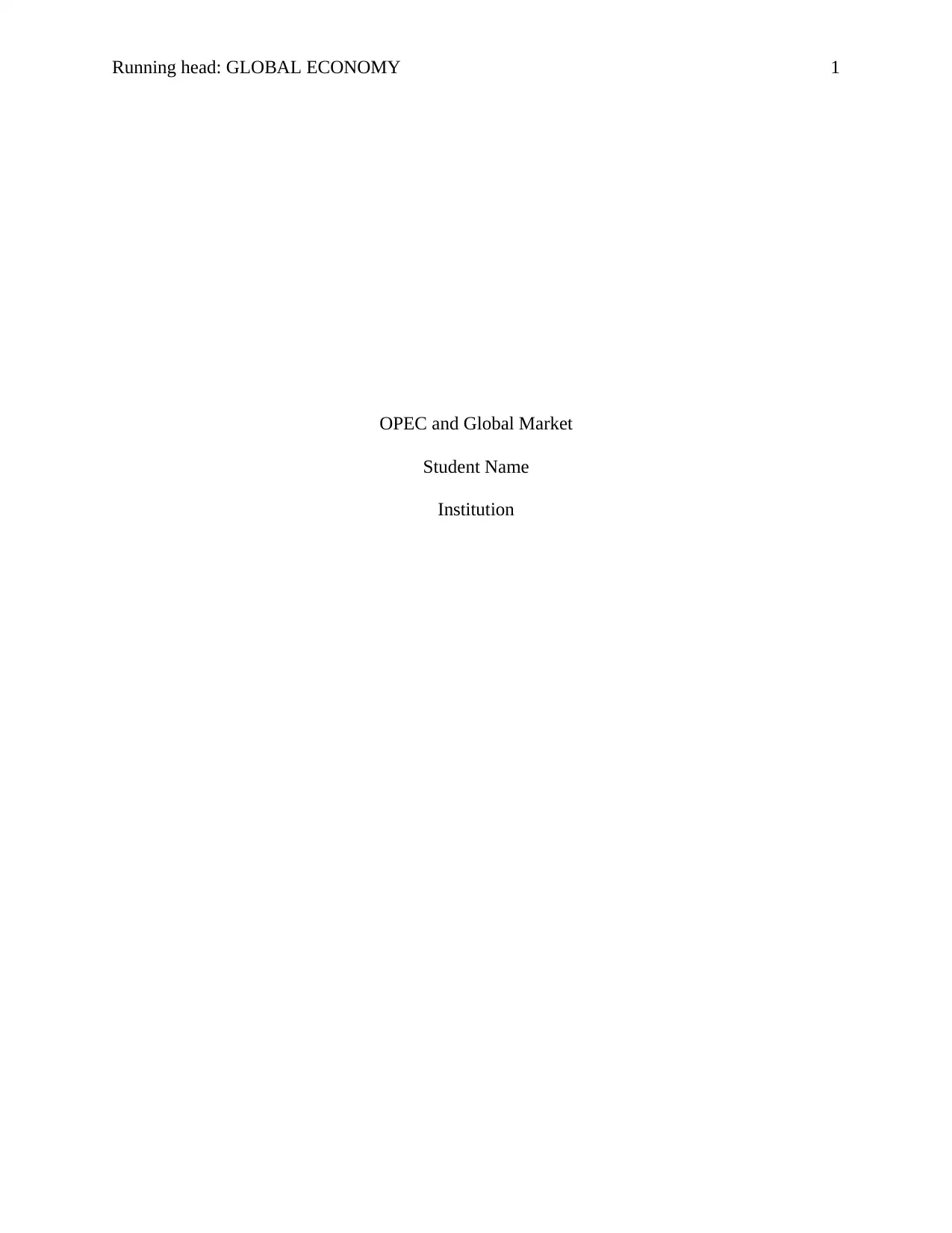
Running head: GLOBAL ECONOMY 1
OPEC and Global Market
Student Name
Institution
OPEC and Global Market
Student Name
Institution
Paraphrase This Document
Need a fresh take? Get an instant paraphrase of this document with our AI Paraphraser
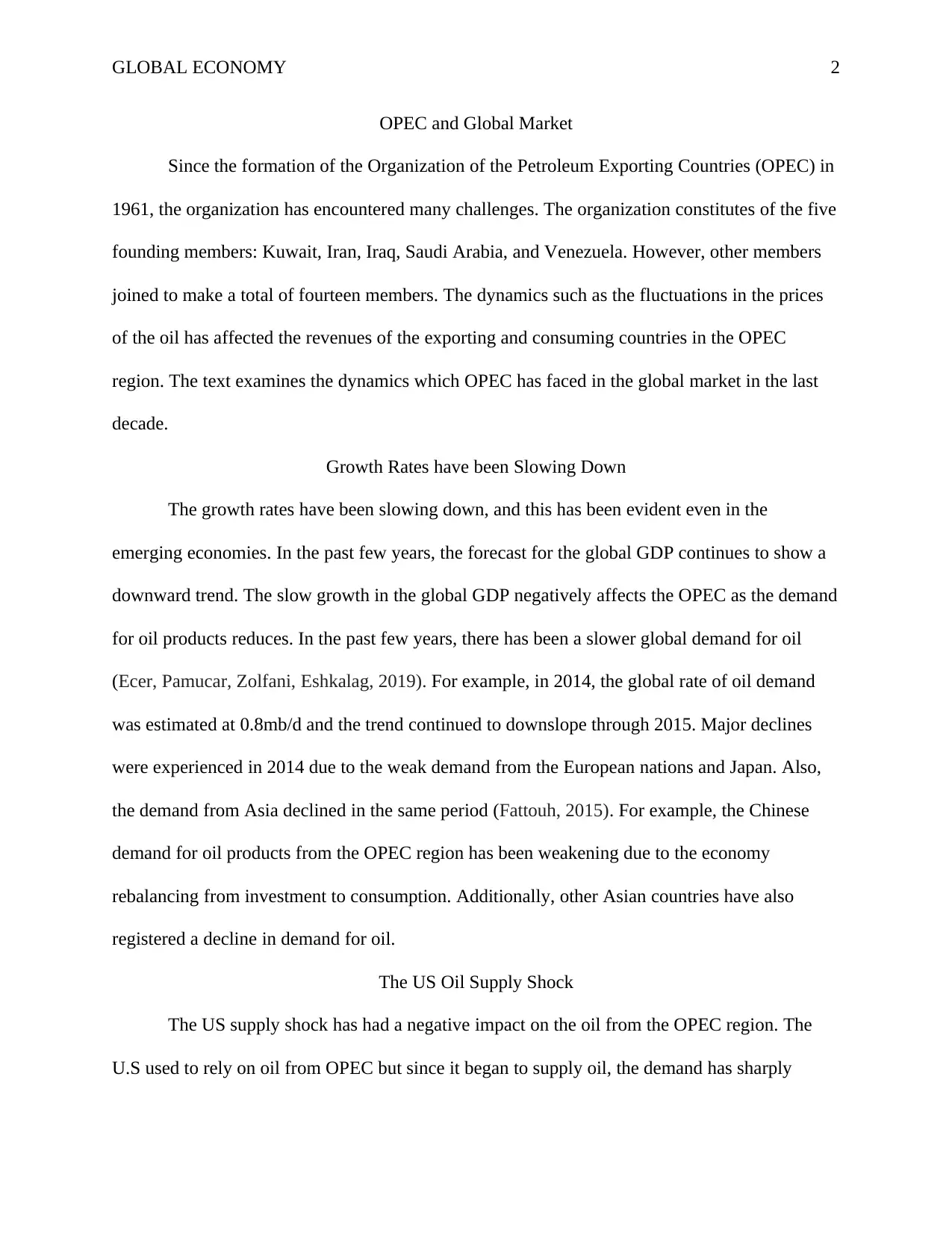
GLOBAL ECONOMY 2
OPEC and Global Market
Since the formation of the Organization of the Petroleum Exporting Countries (OPEC) in
1961, the organization has encountered many challenges. The organization constitutes of the five
founding members: Kuwait, Iran, Iraq, Saudi Arabia, and Venezuela. However, other members
joined to make a total of fourteen members. The dynamics such as the fluctuations in the prices
of the oil has affected the revenues of the exporting and consuming countries in the OPEC
region. The text examines the dynamics which OPEC has faced in the global market in the last
decade.
Growth Rates have been Slowing Down
The growth rates have been slowing down, and this has been evident even in the
emerging economies. In the past few years, the forecast for the global GDP continues to show a
downward trend. The slow growth in the global GDP negatively affects the OPEC as the demand
for oil products reduces. In the past few years, there has been a slower global demand for oil
(Ecer, Pamucar, Zolfani, Eshkalag, 2019). For example, in 2014, the global rate of oil demand
was estimated at 0.8mb/d and the trend continued to downslope through 2015. Major declines
were experienced in 2014 due to the weak demand from the European nations and Japan. Also,
the demand from Asia declined in the same period (Fattouh, 2015). For example, the Chinese
demand for oil products from the OPEC region has been weakening due to the economy
rebalancing from investment to consumption. Additionally, other Asian countries have also
registered a decline in demand for oil.
The US Oil Supply Shock
The US supply shock has had a negative impact on the oil from the OPEC region. The
U.S used to rely on oil from OPEC but since it began to supply oil, the demand has sharply
OPEC and Global Market
Since the formation of the Organization of the Petroleum Exporting Countries (OPEC) in
1961, the organization has encountered many challenges. The organization constitutes of the five
founding members: Kuwait, Iran, Iraq, Saudi Arabia, and Venezuela. However, other members
joined to make a total of fourteen members. The dynamics such as the fluctuations in the prices
of the oil has affected the revenues of the exporting and consuming countries in the OPEC
region. The text examines the dynamics which OPEC has faced in the global market in the last
decade.
Growth Rates have been Slowing Down
The growth rates have been slowing down, and this has been evident even in the
emerging economies. In the past few years, the forecast for the global GDP continues to show a
downward trend. The slow growth in the global GDP negatively affects the OPEC as the demand
for oil products reduces. In the past few years, there has been a slower global demand for oil
(Ecer, Pamucar, Zolfani, Eshkalag, 2019). For example, in 2014, the global rate of oil demand
was estimated at 0.8mb/d and the trend continued to downslope through 2015. Major declines
were experienced in 2014 due to the weak demand from the European nations and Japan. Also,
the demand from Asia declined in the same period (Fattouh, 2015). For example, the Chinese
demand for oil products from the OPEC region has been weakening due to the economy
rebalancing from investment to consumption. Additionally, other Asian countries have also
registered a decline in demand for oil.
The US Oil Supply Shock
The US supply shock has had a negative impact on the oil from the OPEC region. The
U.S used to rely on oil from OPEC but since it began to supply oil, the demand has sharply
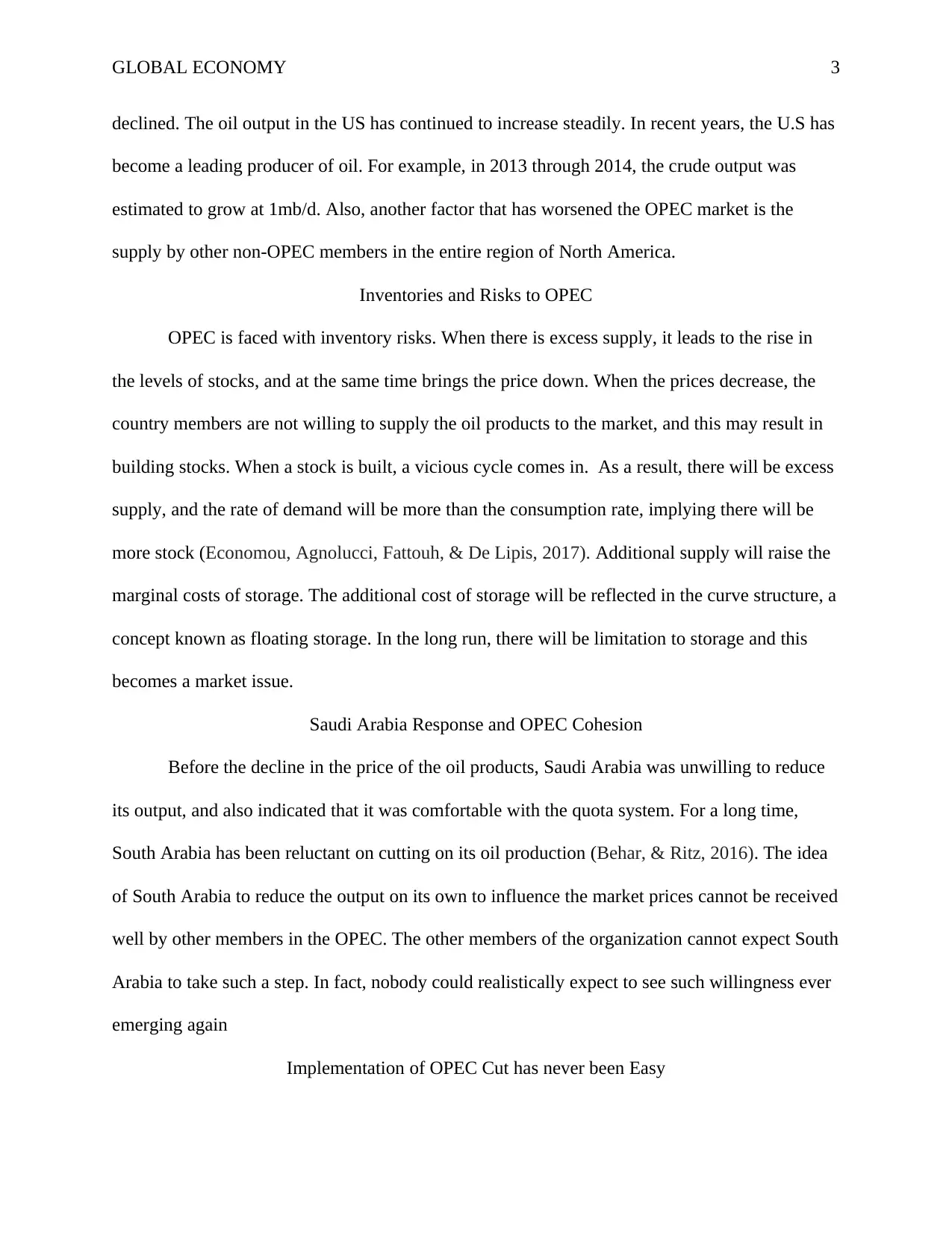
GLOBAL ECONOMY 3
declined. The oil output in the US has continued to increase steadily. In recent years, the U.S has
become a leading producer of oil. For example, in 2013 through 2014, the crude output was
estimated to grow at 1mb/d. Also, another factor that has worsened the OPEC market is the
supply by other non-OPEC members in the entire region of North America.
Inventories and Risks to OPEC
OPEC is faced with inventory risks. When there is excess supply, it leads to the rise in
the levels of stocks, and at the same time brings the price down. When the prices decrease, the
country members are not willing to supply the oil products to the market, and this may result in
building stocks. When a stock is built, a vicious cycle comes in. As a result, there will be excess
supply, and the rate of demand will be more than the consumption rate, implying there will be
more stock (Economou, Agnolucci, Fattouh, & De Lipis, 2017). Additional supply will raise the
marginal costs of storage. The additional cost of storage will be reflected in the curve structure, a
concept known as floating storage. In the long run, there will be limitation to storage and this
becomes a market issue.
Saudi Arabia Response and OPEC Cohesion
Before the decline in the price of the oil products, Saudi Arabia was unwilling to reduce
its output, and also indicated that it was comfortable with the quota system. For a long time,
South Arabia has been reluctant on cutting on its oil production (Behar, & Ritz, 2016). The idea
of South Arabia to reduce the output on its own to influence the market prices cannot be received
well by other members in the OPEC. The other members of the organization cannot expect South
Arabia to take such a step. In fact, nobody could realistically expect to see such willingness ever
emerging again
Implementation of OPEC Cut has never been Easy
declined. The oil output in the US has continued to increase steadily. In recent years, the U.S has
become a leading producer of oil. For example, in 2013 through 2014, the crude output was
estimated to grow at 1mb/d. Also, another factor that has worsened the OPEC market is the
supply by other non-OPEC members in the entire region of North America.
Inventories and Risks to OPEC
OPEC is faced with inventory risks. When there is excess supply, it leads to the rise in
the levels of stocks, and at the same time brings the price down. When the prices decrease, the
country members are not willing to supply the oil products to the market, and this may result in
building stocks. When a stock is built, a vicious cycle comes in. As a result, there will be excess
supply, and the rate of demand will be more than the consumption rate, implying there will be
more stock (Economou, Agnolucci, Fattouh, & De Lipis, 2017). Additional supply will raise the
marginal costs of storage. The additional cost of storage will be reflected in the curve structure, a
concept known as floating storage. In the long run, there will be limitation to storage and this
becomes a market issue.
Saudi Arabia Response and OPEC Cohesion
Before the decline in the price of the oil products, Saudi Arabia was unwilling to reduce
its output, and also indicated that it was comfortable with the quota system. For a long time,
South Arabia has been reluctant on cutting on its oil production (Behar, & Ritz, 2016). The idea
of South Arabia to reduce the output on its own to influence the market prices cannot be received
well by other members in the OPEC. The other members of the organization cannot expect South
Arabia to take such a step. In fact, nobody could realistically expect to see such willingness ever
emerging again
Implementation of OPEC Cut has never been Easy
⊘ This is a preview!⊘
Do you want full access?
Subscribe today to unlock all pages.

Trusted by 1+ million students worldwide
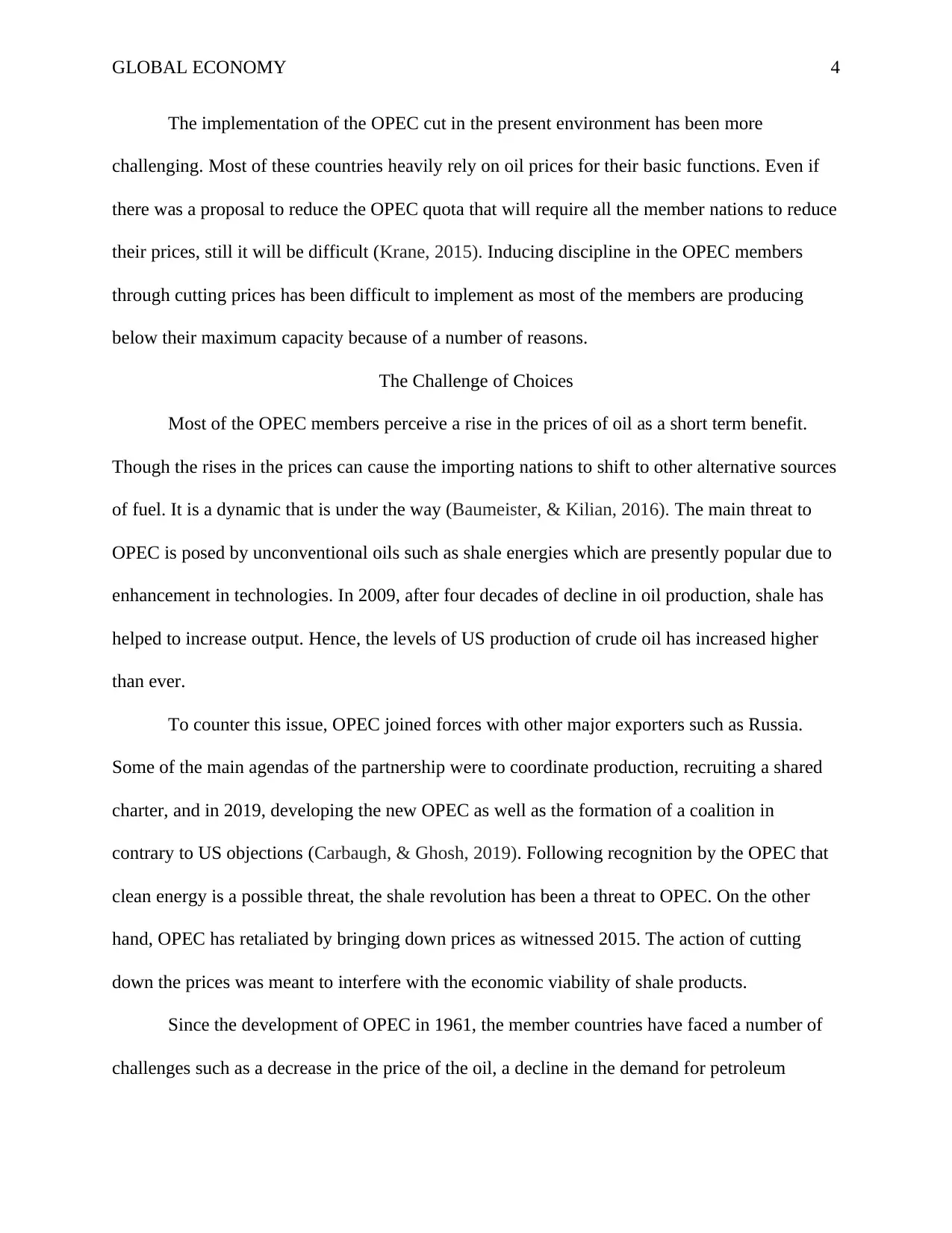
GLOBAL ECONOMY 4
The implementation of the OPEC cut in the present environment has been more
challenging. Most of these countries heavily rely on oil prices for their basic functions. Even if
there was a proposal to reduce the OPEC quota that will require all the member nations to reduce
their prices, still it will be difficult (Krane, 2015). Inducing discipline in the OPEC members
through cutting prices has been difficult to implement as most of the members are producing
below their maximum capacity because of a number of reasons.
The Challenge of Choices
Most of the OPEC members perceive a rise in the prices of oil as a short term benefit.
Though the rises in the prices can cause the importing nations to shift to other alternative sources
of fuel. It is a dynamic that is under the way (Baumeister, & Kilian, 2016). The main threat to
OPEC is posed by unconventional oils such as shale energies which are presently popular due to
enhancement in technologies. In 2009, after four decades of decline in oil production, shale has
helped to increase output. Hence, the levels of US production of crude oil has increased higher
than ever.
To counter this issue, OPEC joined forces with other major exporters such as Russia.
Some of the main agendas of the partnership were to coordinate production, recruiting a shared
charter, and in 2019, developing the new OPEC as well as the formation of a coalition in
contrary to US objections (Carbaugh, & Ghosh, 2019). Following recognition by the OPEC that
clean energy is a possible threat, the shale revolution has been a threat to OPEC. On the other
hand, OPEC has retaliated by bringing down prices as witnessed 2015. The action of cutting
down the prices was meant to interfere with the economic viability of shale products.
Since the development of OPEC in 1961, the member countries have faced a number of
challenges such as a decrease in the price of the oil, a decline in the demand for petroleum
The implementation of the OPEC cut in the present environment has been more
challenging. Most of these countries heavily rely on oil prices for their basic functions. Even if
there was a proposal to reduce the OPEC quota that will require all the member nations to reduce
their prices, still it will be difficult (Krane, 2015). Inducing discipline in the OPEC members
through cutting prices has been difficult to implement as most of the members are producing
below their maximum capacity because of a number of reasons.
The Challenge of Choices
Most of the OPEC members perceive a rise in the prices of oil as a short term benefit.
Though the rises in the prices can cause the importing nations to shift to other alternative sources
of fuel. It is a dynamic that is under the way (Baumeister, & Kilian, 2016). The main threat to
OPEC is posed by unconventional oils such as shale energies which are presently popular due to
enhancement in technologies. In 2009, after four decades of decline in oil production, shale has
helped to increase output. Hence, the levels of US production of crude oil has increased higher
than ever.
To counter this issue, OPEC joined forces with other major exporters such as Russia.
Some of the main agendas of the partnership were to coordinate production, recruiting a shared
charter, and in 2019, developing the new OPEC as well as the formation of a coalition in
contrary to US objections (Carbaugh, & Ghosh, 2019). Following recognition by the OPEC that
clean energy is a possible threat, the shale revolution has been a threat to OPEC. On the other
hand, OPEC has retaliated by bringing down prices as witnessed 2015. The action of cutting
down the prices was meant to interfere with the economic viability of shale products.
Since the development of OPEC in 1961, the member countries have faced a number of
challenges such as a decrease in the price of the oil, a decline in the demand for petroleum
Paraphrase This Document
Need a fresh take? Get an instant paraphrase of this document with our AI Paraphraser
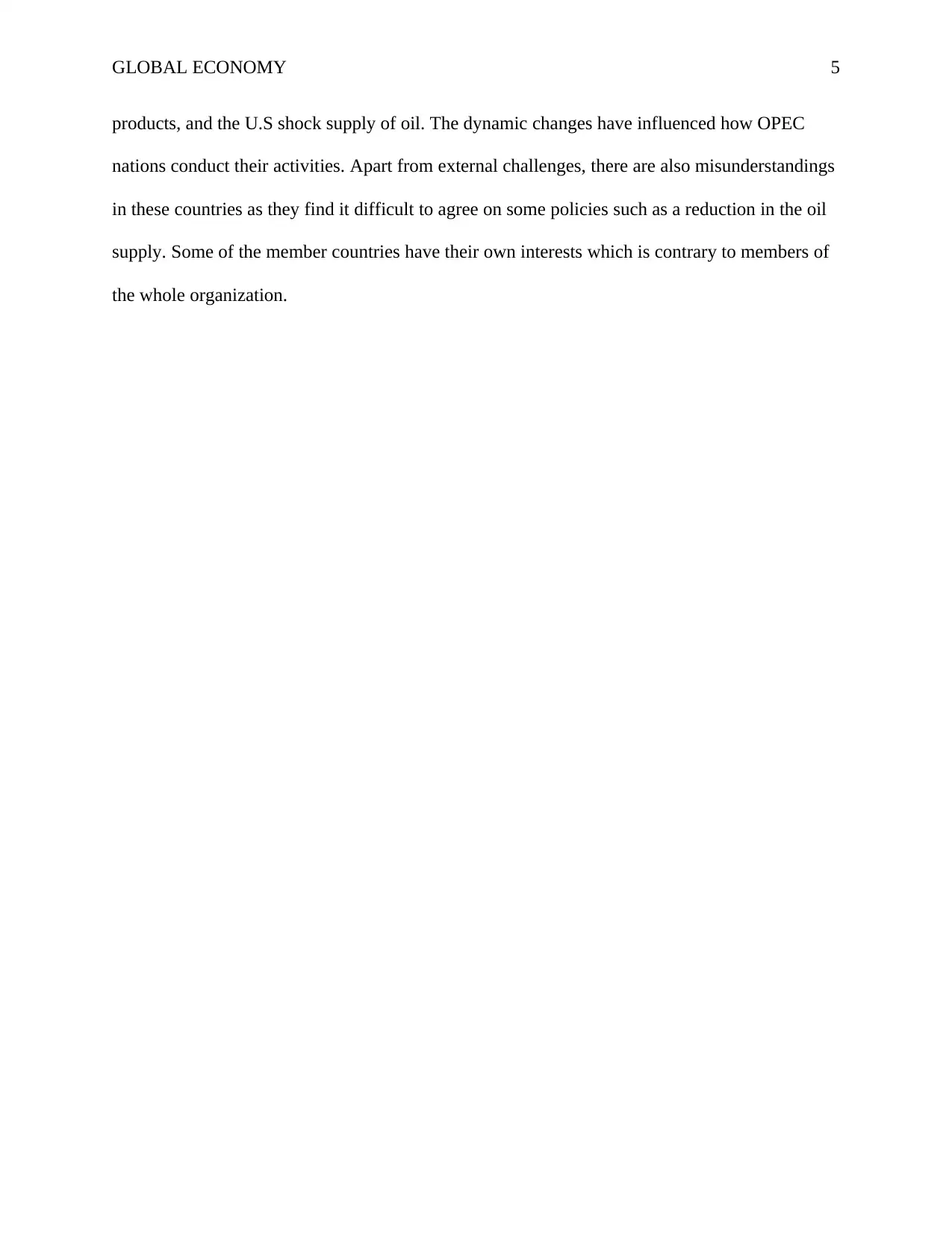
GLOBAL ECONOMY 5
products, and the U.S shock supply of oil. The dynamic changes have influenced how OPEC
nations conduct their activities. Apart from external challenges, there are also misunderstandings
in these countries as they find it difficult to agree on some policies such as a reduction in the oil
supply. Some of the member countries have their own interests which is contrary to members of
the whole organization.
products, and the U.S shock supply of oil. The dynamic changes have influenced how OPEC
nations conduct their activities. Apart from external challenges, there are also misunderstandings
in these countries as they find it difficult to agree on some policies such as a reduction in the oil
supply. Some of the member countries have their own interests which is contrary to members of
the whole organization.
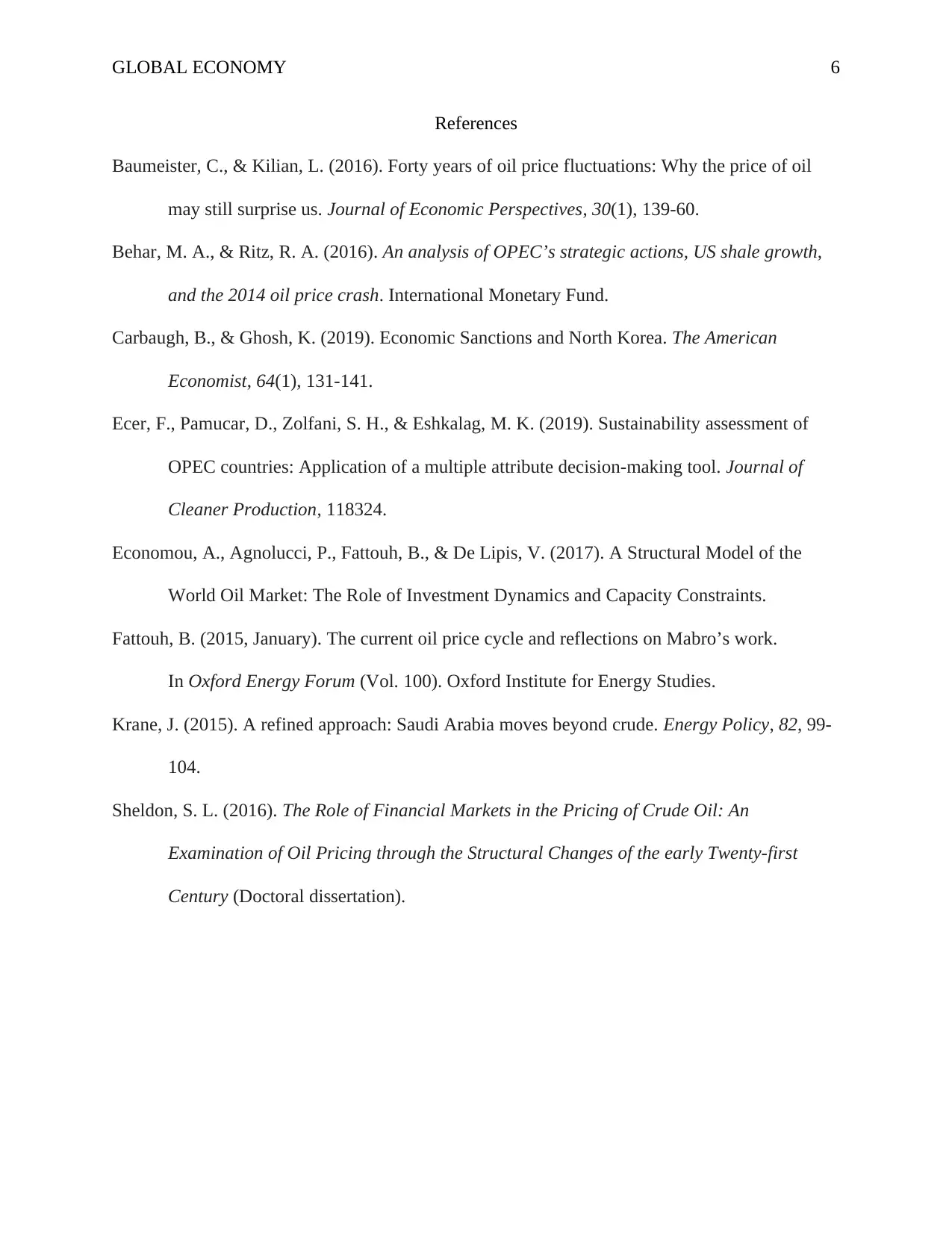
GLOBAL ECONOMY 6
References
Baumeister, C., & Kilian, L. (2016). Forty years of oil price fluctuations: Why the price of oil
may still surprise us. Journal of Economic Perspectives, 30(1), 139-60.
Behar, M. A., & Ritz, R. A. (2016). An analysis of OPEC’s strategic actions, US shale growth,
and the 2014 oil price crash. International Monetary Fund.
Carbaugh, B., & Ghosh, K. (2019). Economic Sanctions and North Korea. The American
Economist, 64(1), 131-141.
Ecer, F., Pamucar, D., Zolfani, S. H., & Eshkalag, M. K. (2019). Sustainability assessment of
OPEC countries: Application of a multiple attribute decision-making tool. Journal of
Cleaner Production, 118324.
Economou, A., Agnolucci, P., Fattouh, B., & De Lipis, V. (2017). A Structural Model of the
World Oil Market: The Role of Investment Dynamics and Capacity Constraints.
Fattouh, B. (2015, January). The current oil price cycle and reflections on Mabro’s work.
In Oxford Energy Forum (Vol. 100). Oxford Institute for Energy Studies.
Krane, J. (2015). A refined approach: Saudi Arabia moves beyond crude. Energy Policy, 82, 99-
104.
Sheldon, S. L. (2016). The Role of Financial Markets in the Pricing of Crude Oil: An
Examination of Oil Pricing through the Structural Changes of the early Twenty-first
Century (Doctoral dissertation).
References
Baumeister, C., & Kilian, L. (2016). Forty years of oil price fluctuations: Why the price of oil
may still surprise us. Journal of Economic Perspectives, 30(1), 139-60.
Behar, M. A., & Ritz, R. A. (2016). An analysis of OPEC’s strategic actions, US shale growth,
and the 2014 oil price crash. International Monetary Fund.
Carbaugh, B., & Ghosh, K. (2019). Economic Sanctions and North Korea. The American
Economist, 64(1), 131-141.
Ecer, F., Pamucar, D., Zolfani, S. H., & Eshkalag, M. K. (2019). Sustainability assessment of
OPEC countries: Application of a multiple attribute decision-making tool. Journal of
Cleaner Production, 118324.
Economou, A., Agnolucci, P., Fattouh, B., & De Lipis, V. (2017). A Structural Model of the
World Oil Market: The Role of Investment Dynamics and Capacity Constraints.
Fattouh, B. (2015, January). The current oil price cycle and reflections on Mabro’s work.
In Oxford Energy Forum (Vol. 100). Oxford Institute for Energy Studies.
Krane, J. (2015). A refined approach: Saudi Arabia moves beyond crude. Energy Policy, 82, 99-
104.
Sheldon, S. L. (2016). The Role of Financial Markets in the Pricing of Crude Oil: An
Examination of Oil Pricing through the Structural Changes of the early Twenty-first
Century (Doctoral dissertation).
⊘ This is a preview!⊘
Do you want full access?
Subscribe today to unlock all pages.

Trusted by 1+ million students worldwide
1 out of 6
Related Documents
Your All-in-One AI-Powered Toolkit for Academic Success.
+13062052269
info@desklib.com
Available 24*7 on WhatsApp / Email
![[object Object]](/_next/static/media/star-bottom.7253800d.svg)
Unlock your academic potential
Copyright © 2020–2025 A2Z Services. All Rights Reserved. Developed and managed by ZUCOL.





